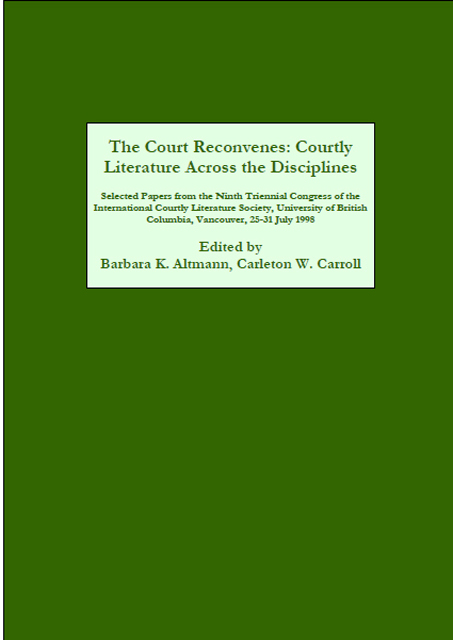 The Court Reconvenes
The Court Reconvenes Published online by Cambridge University Press: 31 March 2023
Much scholarly effort has gone into the study of the anagram (Jakobson, Kristeva, Wunderli), prompted by the writings of Saussure and following the 1971 publication of an (incomplete) edition of Saussure's notebooks by Starobinski. The difficulty has always been to furnish “proof “ – Saussure himself wondered if he were dealing with simple fortuitous coincidences (Jakobson 22). The challenge is to develop a reliable analytical approach permitting researchers to establish the presence of minimal phonemic units capable of operating in anagrammic procedures. In this article, we will present a computer-aided method of analysis (using the text retrieval program TACT) applied to a body of troubadour songs for the purpose of generating a classification of their phonetic content. The “phonetic blueprints” thus identified are used as a norm against which to measure the phonetic profiles of individual songs, leading to the detection of phonemic “agendas” the poets might be exploring. The results will be exemplified in the form of two brief analyses.
The Hypophone
Before we discuss corpus and methodology, we first need to define our terms. For the purpose of this paper, we will adopt Meylakh's definition of the anagram: ”… the phonetic structure of certain key-words, whose semantic contribution in the text is reinforced and valorised throughout the composition by the presence of phonemic fragments of these key-words” (149). What is described here is the non-linear anagram: the scattering, throughout a line of text, of the phonemes of a key word. Saussure and others have used a bewildering array of terms to describe phenomena related to the anagram, such as “paragrams,” “hypograms,” “cryptograms,” and “syllabograms.” Clearly, the common feature in all these terms is the suffix -gram: something that is written. But since the troubadour songs were meant to be heard rather than read, the use of the suffix -phone would appear to be more appropriate than -gram. It may be argued that the presence of anagrams in a text constitutes an added value over and above the meaning conveyed by the linear text and that for that reason, the term hyperphone would be more suitable. However, we elected to adopt the term hypophone, as it aptly expresses the idea of a subliminal meaning hidden below the surface of the linear text.
To save this book to your Kindle, first ensure [email protected] is added to your Approved Personal Document E-mail List under your Personal Document Settings on the Manage Your Content and Devices page of your Amazon account. Then enter the ‘name’ part of your Kindle email address below. Find out more about saving to your Kindle.
Note you can select to save to either the @free.kindle.com or @kindle.com variations. ‘@free.kindle.com’ emails are free but can only be saved to your device when it is connected to wi-fi. ‘@kindle.com’ emails can be delivered even when you are not connected to wi-fi, but note that service fees apply.
Find out more about the Kindle Personal Document Service.
To save content items to your account, please confirm that you agree to abide by our usage policies. If this is the first time you use this feature, you will be asked to authorise Cambridge Core to connect with your account. Find out more about saving content to Dropbox.
To save content items to your account, please confirm that you agree to abide by our usage policies. If this is the first time you use this feature, you will be asked to authorise Cambridge Core to connect with your account. Find out more about saving content to Google Drive.